Several more insects
Jan 11, 2020 01:01:42 #
Here are more memories of last summer. Downloading is recommended.
The first is a male azure bluet damselfly (Enallagma aspersum) [at least I think that it is].
Next up is one of the flower chafer beetles (Trichiotinus sp).
The odd insect shown next is always an exciting find, although this great hobby has brought a few of them to me this summer, and several over the years. This is our large mantidfly (Climaciella brunnea). I have described mantidlies here several times, but to any new viewers I will say that this insect is absolutely not a praying mantis; its similarity to those insects is because of convergent evolution. Like mantises, mantidflies are predators that grab up prey with their front legs. There are several different species, but this one looks very ‘wasp-like’ because it is a mimic of paper wasps. Resembling a wasp presumably grants it considerable protection from birds, and wasps as well since they too are carnivores. Finally, the way mantidflies grow up is just plain weird. Interested readers can find out about that here: https://wiki.bugwood.org/HPIPM:Wasp_Mantidfly Nothing about them is ordinary. This particular species is pretty placid and is reluctant to walk far or fly so I can generally photograph them to my heart’s content. But every time I get one to crawl onto my hand it immediately becomes very agitated and flies away.
I finish with grasshoppers. First is the green-legged grasshopper (Melanoplus viridipes). This was a new species for me last summer.
Next is what I think is yet another new species; the migratory grasshopper (Melanoplus sanguinipes). I have probably seen this numerous times and assumed they were red-legged grasshoppers. But they are a bit different.
Finally, we have an example of an interesting group of grasshoppers called pygmy grasshoppers. These are indeed very small – this fully winged adult (Tetrix sp.) is about 1 cm long (!) Their pronotum (the anterior plate on top of the thorax) is extended to completely cover their abdomen, and that is but one of their unique features. And look at that exquisite camouflage! I can find these near the shorelines of lakes or rivers, but they generally cannot be seen until they move. And if you blink, you can lose sight of them
The first is a male azure bluet damselfly (Enallagma aspersum) [at least I think that it is].
Next up is one of the flower chafer beetles (Trichiotinus sp).
The odd insect shown next is always an exciting find, although this great hobby has brought a few of them to me this summer, and several over the years. This is our large mantidfly (Climaciella brunnea). I have described mantidlies here several times, but to any new viewers I will say that this insect is absolutely not a praying mantis; its similarity to those insects is because of convergent evolution. Like mantises, mantidflies are predators that grab up prey with their front legs. There are several different species, but this one looks very ‘wasp-like’ because it is a mimic of paper wasps. Resembling a wasp presumably grants it considerable protection from birds, and wasps as well since they too are carnivores. Finally, the way mantidflies grow up is just plain weird. Interested readers can find out about that here: https://wiki.bugwood.org/HPIPM:Wasp_Mantidfly Nothing about them is ordinary. This particular species is pretty placid and is reluctant to walk far or fly so I can generally photograph them to my heart’s content. But every time I get one to crawl onto my hand it immediately becomes very agitated and flies away.
I finish with grasshoppers. First is the green-legged grasshopper (Melanoplus viridipes). This was a new species for me last summer.
Next is what I think is yet another new species; the migratory grasshopper (Melanoplus sanguinipes). I have probably seen this numerous times and assumed they were red-legged grasshoppers. But they are a bit different.
Finally, we have an example of an interesting group of grasshoppers called pygmy grasshoppers. These are indeed very small – this fully winged adult (Tetrix sp.) is about 1 cm long (!) Their pronotum (the anterior plate on top of the thorax) is extended to completely cover their abdomen, and that is but one of their unique features. And look at that exquisite camouflage! I can find these near the shorelines of lakes or rivers, but they generally cannot be seen until they move. And if you blink, you can lose sight of them
Bluet damselfly
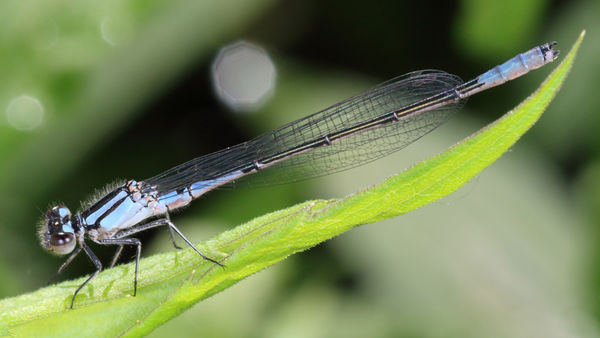
(Download)
Flower chafer beetle
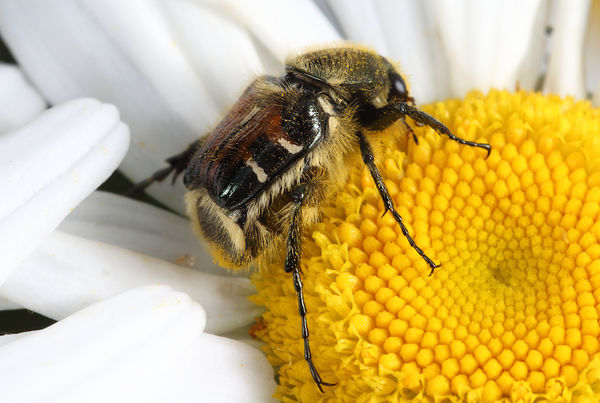
(Download)
Mantidfly
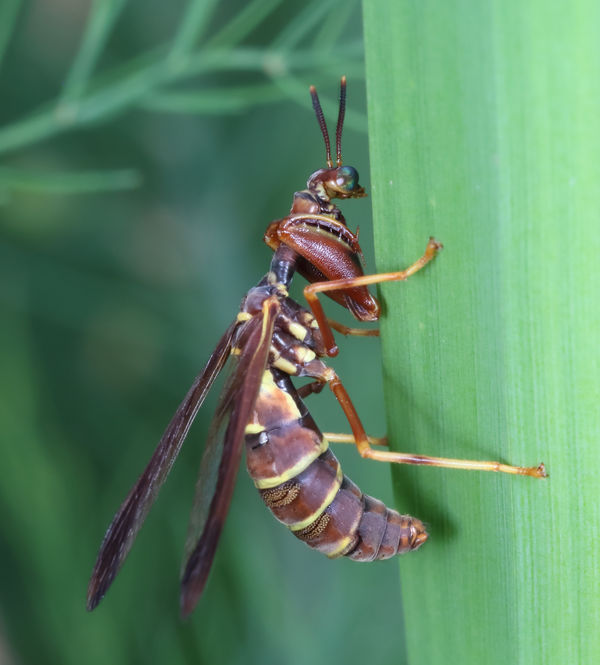
(Download)
Green-legged grasshopper
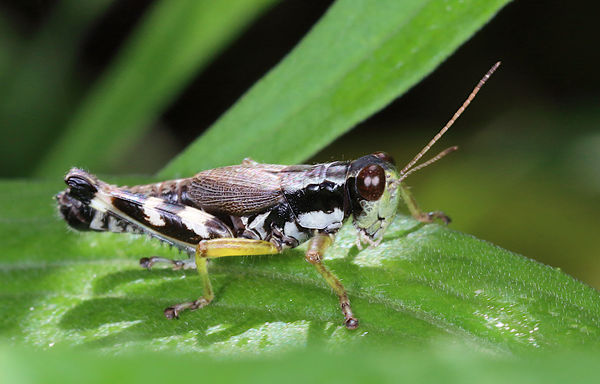
(Download)
Migratory grasshopper
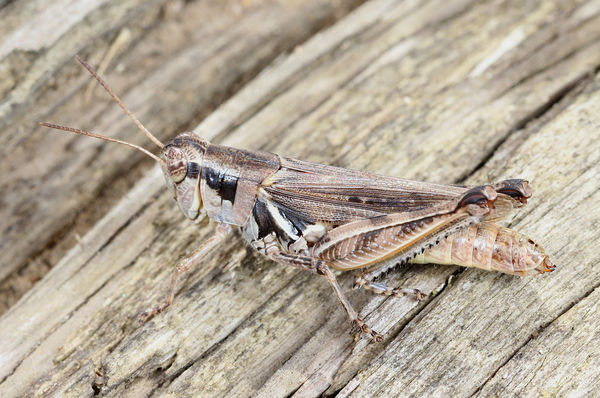
(Download)
Pygmy grasshopper
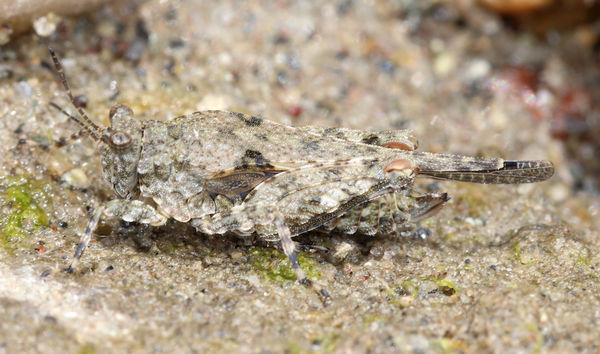
(Download)
Jan 11, 2020 12:03:57 #
Jan 11, 2020 12:06:47 #
Jan 11, 2020 14:32:57 #
tinusbum wrote:
nice! Mantidfly,i want one
All nice.
You may know this. The pigmy grasshoppers overwinter as adults. They are most active in spring and early summer. Then most dissapear.
The nymphs are cryptic and last nymph is only six or seven mm.
Your mantisfly is one of my favorites.
It mimics paper wasps not only in looks, but actions and bearing.
I collected a dozen of these over two summers. Black light on my back porch. I had some large Polistes nests on my porch. That was the source. I have seen them walking on a nest, but have come to believe it was just eclosed.
Could part of the purpose of the mimicry be to escape the nest?
They are good pets. I had them in 4x4x8 inch lucite boxes. The eighth inch air holes let in fruit flies (attracted by a bit of banana or peach, self feeding).
They take prey on the wing.
Thanks for the shots.
Bill
Sorry, got this under wrong member.
Jan 11, 2020 23:29:25 #
newtoyou wrote:
Could part of the purpose of the mimicry be to escape the nest?
They are good pets. I had them in 4x4x8 inch lucite boxes. The eighth inch air holes let in fruit flies (attracted by a bit of banana or peach, self feeding).
They take prey on the wing.
Thanks for the shots.
Bill
Sorry, got this under wrong member.
Could part of the purpose of the mimicry be to escape the nest?
They are good pets. I had them in 4x4x8 inch lucite boxes. The eighth inch air holes let in fruit flies (attracted by a bit of banana or peach, self feeding).
They take prey on the wing.
Thanks for the shots.
Bill
Sorry, got this under wrong member.
All sources that I know say this species are parasitoids on the egg sacs of spiders like wolf spiders and related spiders. There may be pictures in BG to support this. Not all mantidflies grow up on spiders though. Some could be parasitoids in wasp nests.
Jan 13, 2020 06:42:54 #
Excellent set and great information, Mark. I also clicked your include link and had no idea some of these insects existed---thanks!
Jan 13, 2020 11:28:20 #
Mark Sturtevant wrote:
All sources that I know say this species are parasitoids on the egg sacs of spiders like wolf spiders and related spiders. There may be pictures in BG to support this. Not all mantidflies grow up on spiders though. Some could be parasitoids in wasp nests.
Mark.
Although I cannot find it, I have, or had, a reference, on paper, to paper wasp larva being used by this Mantidfly.
Eggs are laid near the nest and the triungulins work their way to the nest. They enter a cell and eat and grow with the larva. When the cell is capped, They finish growth and pupate. The mimicracy may help them to escape the nest.
I think this was new information at the time, 1980 or 81.
I cannot remember the papers author, it was part of someone's PhD dissertation. I had sent him specimens of three mantidfly species.
Hindsight being what it is, I see I should have tried to find them in the nest. However, I did see them on a nest, then they flew. The wasps pay them no mind.
I lived in a damp, wooded area, there were some other strange Neuropterans. My collection went to U of MD, so no pictures.
Enjoy your day.
Bill
Jan 13, 2020 15:44:59 #
newtoyou wrote:
Mark. br Although I cannot find it, I have, or had... (show quote)
I remember you had mentioned this before. This wasp-mimicking species is always described as a parasitoid on wandering spider egg sacs, e.g., wolf spiders and the like. Adults prey on small insects, but they also like to feed on sugar, and are attracted to plant sap and honey-do droppings from aphids. For these reasons they are seen at times in close association with wasps. The link I have above shows this, as does this very interesting video which shows our mantidfly repeatedly having to deal with an angry paper wasp since both want to feed on honey-do. I am sure this video is staged, but still good and interesting: https://www.youtube.com/watch?v=Lldac13hhKs That mantidly has different markings from the one I have photographed, but actually it is the same species. The wasp-like mantidfly comes in different color forms, each being a close mimic of a particular species of paper wasp.
Anyway, it does look like there is a mantidfly that may do what you describe. Different species are parasitioids on different hosts, and on this BugGuide does say this about mantidflies:
"Predatory: Adults eat small insects, caught with their raptorial forelegs. Larvae in the subfamily Mantispinae are restricted to feeding on eggs within egg sacs of spiders. Larvae in the other more primitive subfamilies (i.e. our genera Plega and Nolima) have been reared on immatures of Coleoptera, Lepidoptera, Hymenoptera, and Diptera, spider eggs and paralyzed spiders removed from sphecid cells."
So the reference to Hymenoptera might be the one you are recalling. That is pretty interesting!
Jan 13, 2020 17:42:39 #
Jan 13, 2020 19:38:04 #
Mark Sturtevant wrote:
I remember you had mentioned this before. This was... (show quote)
The repeated reference to the Mantispids eating spider eggs with no other prey, as young, may be a phenomenon that Stephen J Gould describes.
Once a description is used it tends to be repeated in subsequent literature. His example was Ehohippus. The size of a border collie or some similar dog. It is now repeated time and again.
I cannot find anything on Mantispids parasitising wasps. I get led to parasites of preying mantids. Oh well.
Enjoy the evening.
Bill
Jan 13, 2020 23:16:48 #
👍 Gould was not always right (spectacularly wrong at times). But Eohippus was about the size of a border collie. One can find pictures of their skeletons alongside skeletons of a modern horse.
There is some primary literature on the above species of mantidfly:
https://www.biotaxa.org/Zootaxa/article/view/zootaxa.4444.1.4
https://www.tandfonline.com/doi/abs/10.1080/00222938300770041
There is some primary literature on the above species of mantidfly:
https://www.biotaxa.org/Zootaxa/article/view/zootaxa.4444.1.4
https://www.tandfonline.com/doi/abs/10.1080/00222938300770041
Jan 14, 2020 10:29:48 #
Mark Sturtevant wrote:
👍 Gould was not always right (spectacularly wrong at times). But Eohippus was about the size of a border collie. One can find pictures of their skeletons alongside skeletons of a modern horse.
There is some primary literature on the above species of mantidfly:
https://www.biotaxa.org/Zootaxa/article/view/zootaxa.4444.1.4
https://www.tandfonline.com/doi/abs/10.1080/00222938300770041
There is some primary literature on the above species of mantidfly:
https://www.biotaxa.org/Zootaxa/article/view/zootaxa.4444.1.4
https://www.tandfonline.com/doi/abs/10.1080/00222938300770041
He said that the description using border collie was parroted article to article once used.
I looked in a number of places and found it used over 50% of the time and found that 'odd'.
I looked again. I cannot find or no longer have the reference of which I spoke.
Bill
Jan 16, 2020 00:51:15 #
Mark Sturtevant wrote:
Here are more memories of last summer. Downloading... (show quote)
Great shots!
If you want to reply, then register here. Registration is free and your account is created instantly, so you can post right away.






